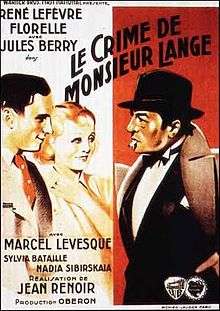The Crime of Monsieur Lange
| The Crime of Monsieur Lange | |
|---|---|
 | |
| Directed by | Jean Renoir |
| Produced by |
André Halley des Fontaines Jean Renoir |
| Written by |
Jean Castanyer Jacques Prévert Jean Renoir |
| Starring |
René Lefèvre Florelle Jules Berry Marcel Lévesque Odette Talazac Henri Guisol Maurice Baquet |
| Music by |
Joseph Kosma Jean Wiener |
Release dates | 1936 |
Running time | 80 min |
| Language | French |
The Crime of Monsieur Lange (pronounced: [mə.sjø lɑ̃ʒ]; French: Le Crime de Monsieur Lange) is a 1936 film directed by Jean Renoir about a publishing cooperative. An idyllic picture of a socialist France, the film is part social commentary and part romance.
Plot
Imbued with the spirit of the left-wing political movement, Popular Front, which would have a major political victory that year, the film chronicles the story of M. Lange (René Lefèvre), a mild-mannered clerk at a publishing company who dreams of writing Western stories. He gets his chance when Batala (Jules Berry), the salacious head of the company, fakes his own death and the abandoned workers decide to form a cooperative. They have great success with Lange's stories about the cowboy, Arizona Jim — whose stories parallel the real-life experiences of the cooperative. At the same time, Lange and his neighbor, Valentine (Florelle), fall in love.
When Batala returns from the "dead", intending to reclaim the publishing company, Lange shoots and kills him (the "crime" of the title). Lange and Valentine flee to escape the country, stopping at an inn near the Belgian border. Here, Valentine tells Lange's story to a group of the inn's patrons, who had recognized Lange as the "murderer on the run" and threatened to turn him in to the police. After the story is through, the men sympathize with Lange and decide to allow him to escape across the border to freedom.
Cast
- René Lefèvre — Amédée Lange
- Florelle — Valentine Cardès
- Jules Berry — Paul Batala
- Marcel Lévesque — The concierge
- Odette Talazac — The concierge's wife
- Sylvia Bataille — Edith
- Nadia Sibirskaïa — Estelle
- Henri Guisol — The son Meunier
- Maurice Baquet — Charles, the concierges' son
- Jacques B. Brunius (as J.B. Brunius) — Mr. Baigneur
- Sylvain Itkine — Inspector Juliani, Batala's cousin
- Marcel Duhamel — Louis, the foreman
- René Génin (as Génin) - A client at the Auberge Inn
- Max Morise - Man with the pipe
- Jean Dasté — The model maker
- Paul Demange - Creditor
Production
Renoir considered the film a collaboration between himself and First Groupe Octobre. It was based on an original idea by Renoir and Jean Castanier called Sur la cour. Prevert wrote script.[1] The shooting lasted 25 days[2] and took place from October to November 1935, at Tréport and Paris in the studios of Billancourt. It was during the shooting of this film that Paul Éluard introduced Pablo Picasso to Dora Maar, who served as set photographer for the production.[3]
Legacy
In his autobiography, Renoir claimed that the great success of The Crime of Monsieur Lange in France led to his becoming strongly associated with the political left wing, so that the Communist Party asked him to make propaganda films denouncing fascism, a request with which Renoir was happy to comply, stating, "I believed that every honest man owed it to himself to resist Nazism. I am a filmmaker, and this is the only way in which I could play a part in the battle."[4] The films of the mid-1930s, starting with The Crime of Monsieur Lange, along with his writings for various newspapers, put Renoir in personal danger when Germany began hostilities with France, and friends in America, particularly the filmmaker Robert Flaherty, urged him to obtain a visa to the United States from the consulate in Nice. He decided to do so after he was visited by Nazis who attempted to recruit him into making films for the "New France".[5]
Roger Leenhardt of Espirit called it "all the more remarkable in that the work owes its witty style to the harmony of…two unshakably original temperaments…Prevert contributed his vivacity and mordant humor, and Renoir the resonance of his true romanticism."[6] Peter Harcourt said it was "in a sense the most intelligent film…Renoir ever made."[7] François Truffaut wrote that "Mr. Lange is all Renoir's films, the most spontaneous, the most dense set of miracles and camera, the busiest of truth and pure beauty, a film we would say touched by grace."
See also
References
Sources
Renoir, Jean. My Life and My Films. New York: Da Capo Press, 2000. ISBN 978-0306804571